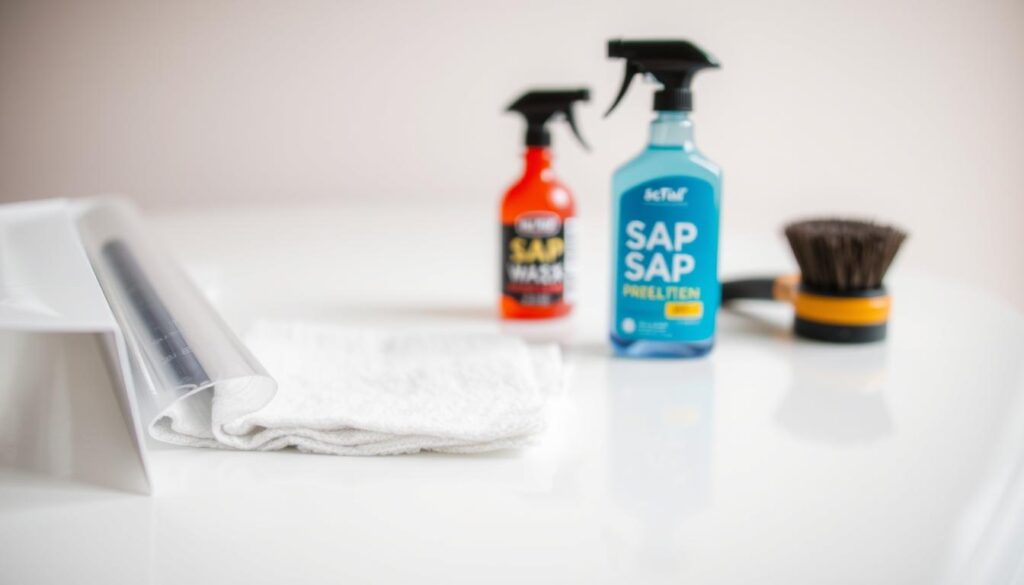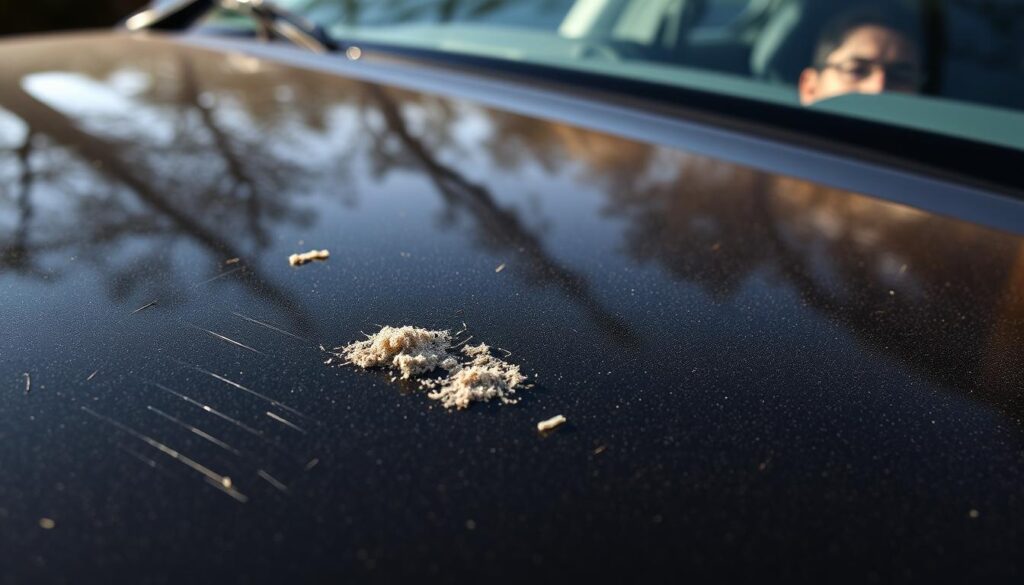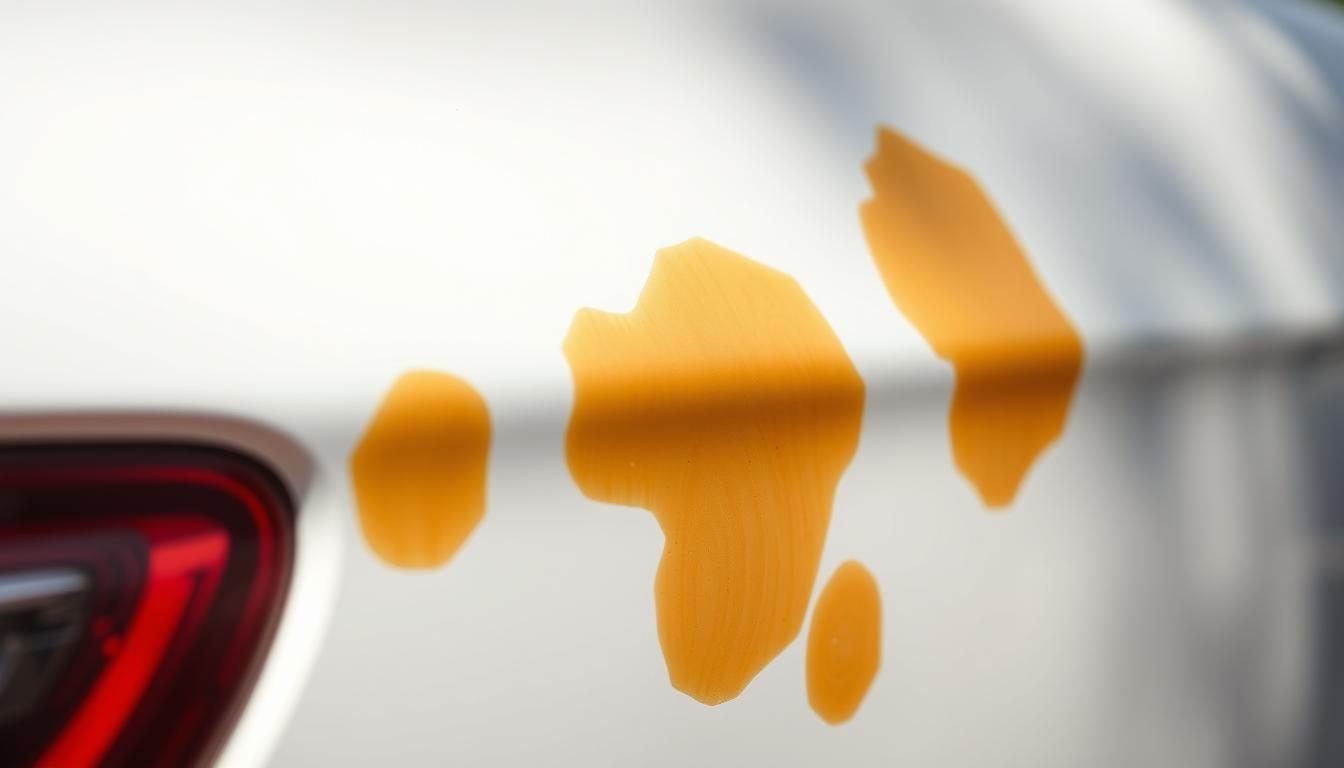Every car lover knows the pain of finding tree sap in their car. That moment you see sticky, hardened resin on your car’s paint is upsetting. It can ruin a good day and harm your car’s look and value.
Tree sap can damage your car’s paint if not removed quickly. Its acidic nature can etch into the paint, leaving stubborn stains. These stains are ugly; they can harm your car’s exterior.
Knowing how to remove tree sap is key. With the right steps, you can keep your car’s paint looking new. This guide will show you five important tricks to remove car sap stains effectively.
Table of Contents
Understanding Tree Sap and Its Impact on Automotive Paint
Tree sap can ruin a car’s paint job, making it sticky and damaged. It’s not just a cosmetic problem. The damage starts as soon as sap touches your car’s paint.
Not all tree sap is the same. Some types can cause more harm than others.
Types of Tree Sap That Damage Cars
- Pine sap: Extremely sticky and resinous
- Maple sap: Thick and difficult to remove
- Oak tree sap: Dark and potentially staining
- Fruit tree sap: Sugar-rich and quick to harden
Chemical Composition of Tree Sap
Tree sap has complex compounds that bond with car paint. These include sugars, proteins, and resins. They can damage your car’s clear coat quickly.
How Sap Bonds with Paint Surfaces
When sap hits your car, it bonds fast with the paint. Sunlight makes it harder to remove. The longer it stays, the worse the damage gets.
Pro tip: Fresh sap is significantly easier to remove within the first 24 hours of exposure.
Knowing how tree sap works can help protect your car. Quick action and the right removal methods are key to avoiding expensive repairs.
| Sap Type | Removal Difficulty | Potential Paint Damage |
|---|---|---|
| Pine Sap | High | Significant |
| Maple Sap | Medium | Moderate |
| Fruit Tree Sap | Low | Minor |
Essential Tools and Products for Sap Removal
Removing tree sap from your car needs a smart plan and the right tools. Maple sap can harm your vehicle if not removed fast and right. Detailers suggest a special toolkit for effective sap removal.
Must-Have Tools for Effective Sap Removal
- Microfiber towels (soft and non-abrasive)
- Specialized Bug & Tar Remover
- Isopropyl alcohol
- Automotive clay bar
- Protective gloves
- Soft cleaning cloth
Choosing the right products is key for sap removal. Automotive-approved solutions prevent paint damage and ensure a clean finish.
Recommended Cleaning Products Comparison
| Product Type | Effectiveness | Paint Safety |
|---|---|---|
| Specialized Sap Remover | High | Excellent |
| Isopropyl Alcohol | Medium | Good |
| Clay Bar | High | Very Good |
Always conduct a patch test on a small, inconspicuous area first. Use gentle, car-specific cleaners to avoid scratches or more damage.
Act fast. The longer sap stays on your car, the tougher it is to remove. This increases the risk of permanent paint damage.
Tree Sap on Car: Immediate Action Steps
Tree sap on your car can be stressful. Quick action is key to avoiding paint damage. The longer it remains, the more difficult it becomes to remove.
- Act fast to stop sap from hardening
- Clean in the shade to slow bonding
- Avoid sunlight to prevent sap from setting in paint
Safe Initial Cleaning Methods
For effective sap removal, you’ll need:
- Rubbing alcohol (isopropyl alcohol)
- Soft microfiber cloth
- Warm water
- Car wax
Time-Sensitive Response Guide
Removing sap gets harder with time. Wait at least 30 seconds after applying rubbing alcohol before trying to remove the sap. You might need to clean it multiple times.
Professional Assessment Indicators
Get professional help if you see:
- Too much sap
- Paint discoloration
- Clear coat damage risk
- Hard sap to remove with basic methods
Quick and careful action can protect your car’s paint.
Professional Cleaning Solutions vs. Home Remedies
Car owners face a big choice when dealing with tree resin on their cars. They can use professional cleaning solutions or try home remedies. Each option has its own benefits and risks for your car’s paint.
Professional car cleaning services have the skills to handle tough tree sap. Star Car Wash, with over 20 years of experience, shows the importance of professional help. Their team knows how to safely remove sap without harming your car’s paint.
- Professional services can save a lot of time
- Specialized equipment lowers the risk of paint damage
- Experts know how to protect your car’s paint
Home remedies might seem cheaper, but they’re not without problems. Items like isopropyl alcohol can remove sap in about 80% of cases. But, using it wrong can harm your car’s finish.
When deciding between professional help and DIY, consider a few things:
- How bad is the sap damage is
- Your skill level with DIY
- How much time and resources you have
- The risk to your car’s paint
Professional sap removers are made just for cars, which means less risk of paint damage. Experts say to test any cleaning product first and check your car monthly to avoid long-term damage from sap.
Regular maintenance and quick action are key to keeping your car looking good and valuable.
Step-by-Step Sap Removal Techniques
Removing sticky sap from your car’s paint can be tough. It needs a careful, step-by-step approach to keep your car looking good. This way, you avoid permanent damage.
Knowing the right methods can save your car’s paint and avoid expensive fixes. Tree sap sticks fast to your car’s surface. So, quick and correct removal is key.
Pre-Treatment Process
First, get these important tools ready:
- Microfiber cloths
- Specialized Bug & Tar Remover
- Soft detailing clay
- Isopropyl alcohol
Main Cleaning Application
Here are the main steps for removing sap:
- Soften the sap with a special remover
- Apply the product gently with a microfiber cloth
- Use a clay bar for tough sap
- Don’t scrape or use sharp objects
Post-Cleaning Care
After removing sap, protect your car’s paint with these steps:
- Wash the area well with pH-neutral automotive shampoo
- Apply a good wax or paint sealant
- Check for any leftover residue
Removing tree sap fast is very important. If you wait too long, it can damage your car’s paint. For big problems, you might need a pro’s help.
Preventing Future Sap Damage

Keeping your car’s paint safe from tree sap is key. Sap can harm your car’s paint in just a few days. So, it’s important to act fast to keep your car looking good and valuable.
To avoid sap damage, try these steps:
- Choose parking spots away from trees when you can
- Use a high-quality sap-resistant car wax
- Invest in a car cover for outdoor parking
- Wash your car regularly
Using sap-resistant car wax is a must. The right wax can boost your paint’s protection by up to 50%. This stops sap from sticking and makes cleaning easier later on.
| Prevention Method | Effectiveness | Effort Required |
|---|---|---|
| Regular Washing | 70% Reduction in Sap Accumulation | Low |
| Protective Waxing | 50% Increased Paint Protection | Medium |
| Car Covers | 85% Sap Prevention | High |
UV rays make sap harden faster, so act fast. Washing your car every week can stop sap from sticking. This saves your car from damage and costly fixes.
- Apply sap-resistant car wax every 3-4 months
- Wash your car weekly
- Check for sap after parking under trees
- Use microfiber cloths for gentle cleaning
Protecting your car from tree sap is more than looks. It’s about keeping your car’s value up and avoiding expensive fixes or repaints.
Paint Protection and Maintenance After Sap Removal
After removing tree sap from your vehicle, protecting your car’s paint is key. Sap damage can cause long-term problems if not handled right. The right maintenance techniques are essential.
Creating a solid protection plan will keep your vehicle’s finish safe. It will also keep it looking new.
Waxing and Sealing Methods
Protecting your car’s surface needs smart strategies. Here are some important methods:
- Apply sap-resistant car wax every 3-4 months
- Use high-quality ceramic coatings for extended protection
- Select UV-resistant wax products
“Consistent protection is your best defense against environmental contaminants.”
Long-Term Protection Strategies
Using top-notch protection methods can make your paint last longer. Ceramic coatings are a big plus:
- Create a hydrophobic barrier against sap and debris
- Reduce wash frequency by 30%
- Enhance vehicle appearance by up to 20%
Regular Maintenance Schedule
Make a regular maintenance plan to keep your car’s finish in top shape:
- Wash weekly with pH-neutral soap
- Inspect for potential sap or contaminant buildup
- Reapply protective coating every 6-12 months
- Park in covered or shaded areas when possible
By sticking to these protection strategies, you can avoid sap damage. This will help keep your vehicle looking great for years.
Common Mistakes to Avoid During Sap Removal

Removing tree sap from your car can be challenging. Many people accidentally damage their car’s paint while trying to remove sap. Knowing the common mistakes can help you avoid expensive repairs and keep your paint looking good.
Here are the most critical mistakes to avoid during tree sap removal:
- Using Abrasive Materials: Scraping or using rough materials can permanently scratch your car’s paint surface
- Applying excessive pressure when cleaning, can push sap deeper into the paint
- Neglecting to test cleaning solutions on a small area first
- Using household cleaners not designed for automotive surfaces
About 70% of car owners have had to deal with tree sap damage. If sap is not treated, it can make the paint look dull. Fixing this damage can cost between $150 and $500.
Proper tree sap on car removal requires gentle techniques:
- Use specialized automotive cleaning products
- Apply soft microfiber towels
- Work in a cool, shaded area
- Be patient and avoid rushed cleaning methods
Professional detailers suggest using clay bar treatments to remove sap. Rubbing alcohol can also work well if used correctly.
Remember: Quick action and gentle treatment are key to preventing permanent paint damage.
When to Seek Professional Help
Dealing with tree resin on cars can be challenging. Sometimes, DIY efforts may not be enough for tough sap problems. Knowing when to call professionals can protect your car’s paint from lasting damage.
Professional help is key in several situations:
- Extensive tree sap coverage across multiple areas of your vehicle
- Dried or hardened sap that has been on the surface for an extended period
- Visible signs of paint etching or surface damage
- Multiple failed attempts at pitch removal from cars
Auto detailing experts have special tools and methods. They can handle different types of tree sap without harming your car’s finish.
When looking for a professional service, consider these points:
- Check for certified detailing credentials
- Read customer reviews and testimonials
- Verify their experience with tree sap removal
- Request a detailed assessment before service
Pro tip: Waiting too long can turn a simple sap issue into a big repair. Getting professional help early can stop long-term paint damage and keep your car looking good.
While DIY can work for small, fresh sap spots, pros are your best defense against big tree resin damage to your car’s paint.
Conclusion
Managing tree sap on cars needs careful planning and early action. Since 25% of car owners face sap issues every year, knowing how to prevent and remove it is key. Keeping your car’s paint safe is the main goal.
To avoid sap damage, use several strategies. Park your car away from trees that drop sap, like pine and maple. Clean your windshield often in spring and early summer to prevent harm. A good waterproof car cover also helps protect against the elements.
Act fast if you see tree sap on your car. The longer it stays, the more damage it can cause. Use both professional tips and DIY methods to keep your car’s exterior in top shape. Regular waxing and smart cleaning, along with careful parking, will keep your car looking great all year.
Protecting your car from tree sap is all about being ready and taking action. With the right information and tools, you can avoid expensive fixes and keep your car looking good. Stay alert, act fast, and your car will stay beautiful and sap-free.
FAQ
How quickly can tree sap damage my car’s paint?
Tree sap can start damaging your car’s paint in hours to days. The longer it remains, the tougher it is to remove. This increases the risk of permanent damage. It’s important to act fast to avoid lasting harm.
What types of tree sap are most damaging to car paint?
Pine, maple, and resinous tree saps are the worst. They have sticky compounds that bond with your car’s paint. This makes tough stains that are hard to get rid of. Pine and maple saps are especially bad if not treated right away.
Can I remove tree sap with household products?
Some home remedies work, but be careful not to harm your car’s paint. Isopropyl alcohol, hand sanitizer, and special sap removers are safer. Avoid harsh chemicals or abrasive materials that could scratch your paint.
How often should I check my car for tree sap?
Check your car weekly in spring and summer when trees are busy. If you park under trees often, check more often. Catching sap early makes removal easier and prevents damage.
What tools do I need to safely remove tree sap?
You’ll need microfiber towels, clay bars, isopropyl alcohol, and special sap removers. Use soft materials to avoid scratching your car’s paint.
Is professional sap removal worth the cost?
Yes, if the sap is all over your car or has been there for a long time. Professionals can remove sap safely and avoid expensive paint repairs.
How can I protect my car from tree sap damage?
Park away from trees, use car covers and apply sap-resistant wax. Regular waxing and sealing also help. These steps create a barrier against sap and make removal easier.
What are the signs of permanent paint damage from tree sap?
Look for discoloration, etching, paint bubbling, or stains that won’t come off. If you see these, you might need professional detailing or paint correction to fix your car’s finish.
Can tree sap damage occur in all seasons?
Yes, tree sap can damage your car all year. Winter sap is especially hard to remove and can cause more damage.
How long does professional sap removal typically take?
It usually takes 1-3 hours, depending on how much sap there is. Some jobs might take longer to ensure safe and complete removal without harming your paint.

